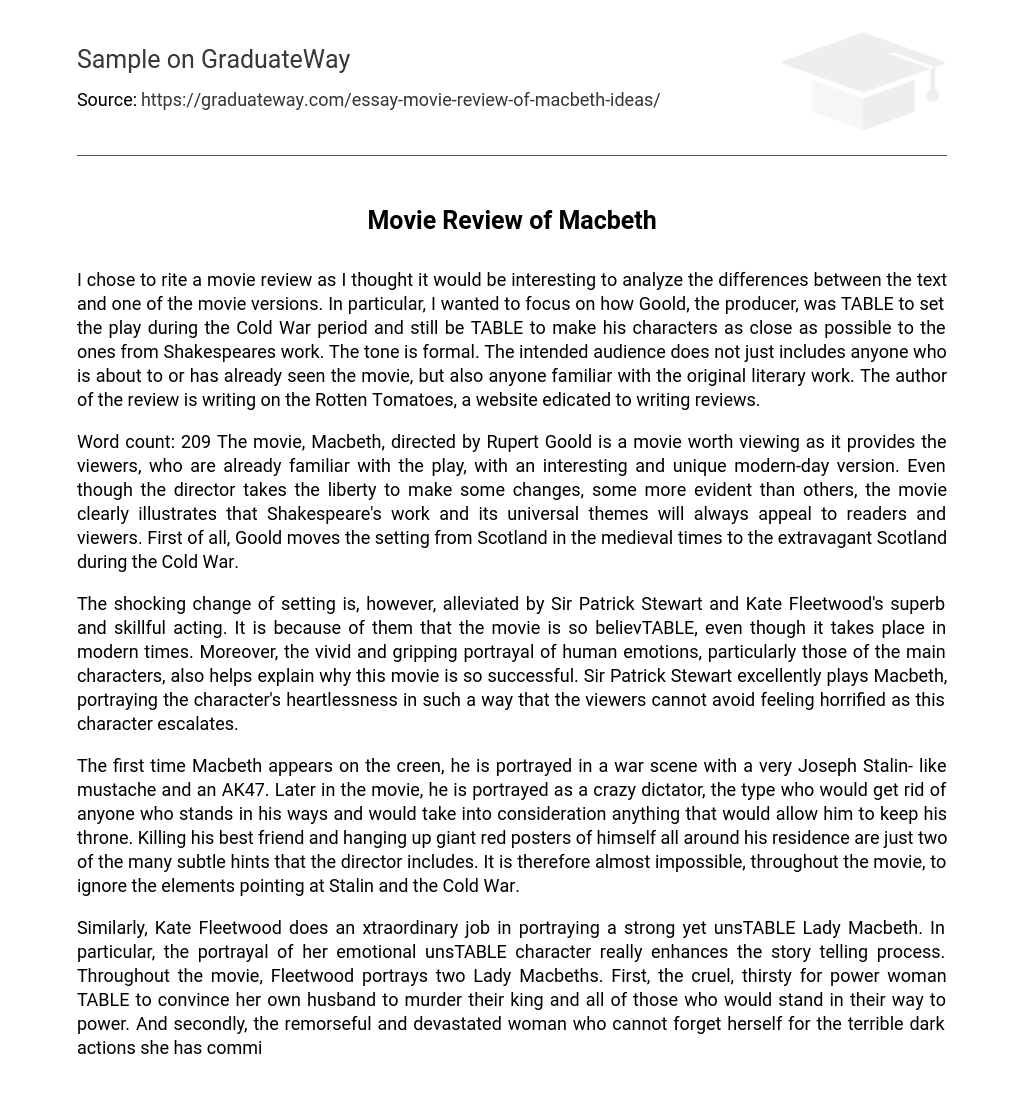I chose to rite a movie review as I thought it would be interesting to analyze the differences between the text and one of the movie versions. In particular, I wanted to focus on how Goold, the producer, was TABLE to set the play during the Cold War period and still be TABLE to make his characters as close as possible to the ones from Shakespeares work. The tone is formal. The intended audience does not just includes anyone who is about to or has already seen the movie, but also anyone familiar with the original literary work. The author of the review is writing on the Rotten Tomatoes, a website edicated to writing reviews.
Word count: 209 The movie, Macbeth, directed by Rupert Goold is a movie worth viewing as it provides the viewers, who are already familiar with the play, with an interesting and unique modern-day version. Even though the director takes the liberty to make some changes, some more evident than others, the movie clearly illustrates that Shakespeare’s work and its universal themes will always appeal to readers and viewers. First of all, Goold moves the setting from Scotland in the medieval times to the extravagant Scotland during the Cold War.
The shocking change of setting is, however, alleviated by Sir Patrick Stewart and Kate Fleetwood’s superb and skillful acting. It is because of them that the movie is so believTABLE, even though it takes place in modern times. Moreover, the vivid and gripping portrayal of human emotions, particularly those of the main characters, also helps explain why this movie is so successful. Sir Patrick Stewart excellently plays Macbeth, portraying the character’s heartlessness in such a way that the viewers cannot avoid feeling horrified as this character escalates.
The first time Macbeth appears on the creen, he is portrayed in a war scene with a very Joseph Stalin- like mustache and an AK47. Later in the movie, he is portrayed as a crazy dictator, the type who would get rid of anyone who stands in his ways and would take into consideration anything that would allow him to keep his throne. Killing his best friend and hanging up giant red posters of himself all around his residence are just two of the many subtle hints that the director includes. It is therefore almost impossible, throughout the movie, to ignore the elements pointing at Stalin and the Cold War.
Similarly, Kate Fleetwood does an xtraordinary job in portraying a strong yet unsTABLE Lady Macbeth. In particular, the portrayal of her emotional unsTABLE character really enhances the story telling process. Throughout the movie, Fleetwood portrays two Lady Macbeths. First, the cruel, thirsty for power woman TABLE to convince her own husband to murder their king and all of those who would stand in their way to power. And secondly, the remorseful and devastated woman who cannot forget herself for the terrible dark actions she has committed.
The juxtaposition of the two Lady Macbeths played by Fleetwood does not just nrich the plot, but also greatly contributes to take the viewers’ attention away from the changes made by the director. The actresses Sophie Hunter, Niamh McGrady, and Polly Frame who played the three witches did a great job as well. The characters almost looked like they were coming right out of a modern horror movie because of their tone, movements, and looks. Moreover, the director silently includes them in scenes where they originally did not belong. Even though this might seem a subtle and irrelevant change, it actually carries a lot of meaning.
In fact, this fact stresses the importance of their roles and suggests to the viewers that the three witches are always watching. Moreover, the fact that in those scenes, most of the time, they do not even speak, simply emphasizes how fundamental they are for the story telling process. In addition, not all of Shakespeare’s characters are included in some of the scenes of the movie. It was surprising, especially for those who have read the original text not to see Lennox, for instance, in the scene right after Duncan’s body is discovered. Furthermore, the director includes in he movie scenes that could have been easily cut out.
That is because their presence or absence would not have added or taken away from the movie any fundamental information. I would not consider the scene where the Porter Seyton urinates in a sink, for instance, to be one of the essential ones if compared to others. Furthermore, some of the scenes are very graphic, even gruesome. In particular, the scenes of the murders ordered by Macbeth contain an abundant amount of violence. This allows the movie to connect to the original work, as the portrayal of such scenes literally corresponds to Shakespeare’s descriptions.
The movie is true to the play also because Shakespeare’s dialogues are used, word for word, by the actors in the movie. Goold’s film version is, in a way, also a dramatic production. A Very clear example is provided by the presence of soliloquies, which are recited as if the characters were on stage. For instance, the way Stewart recites Macbeth’s soliloquy, in the scene where he speaks to the two murders about Banquo’s threatening his rise to power, can be considered as such. Moreover, it captivates the viewers’ attention and enriches the plot.
Throughout the movie, the director also does a great work when it comes to choose the most suspenseful, terrifying, and electrifying sounds and music possible. He does this in order to convey a chilling mood, to add to the movie tragedy and drama, and to foreshadow some evil events. It might seem like the director created a new play, because of the several changes, but that is not the case. It is Macbeth, one of the many Shakespearian’s works that can be set in any time period and still work perfectly. It is one of the literary works we’re still reading today.





